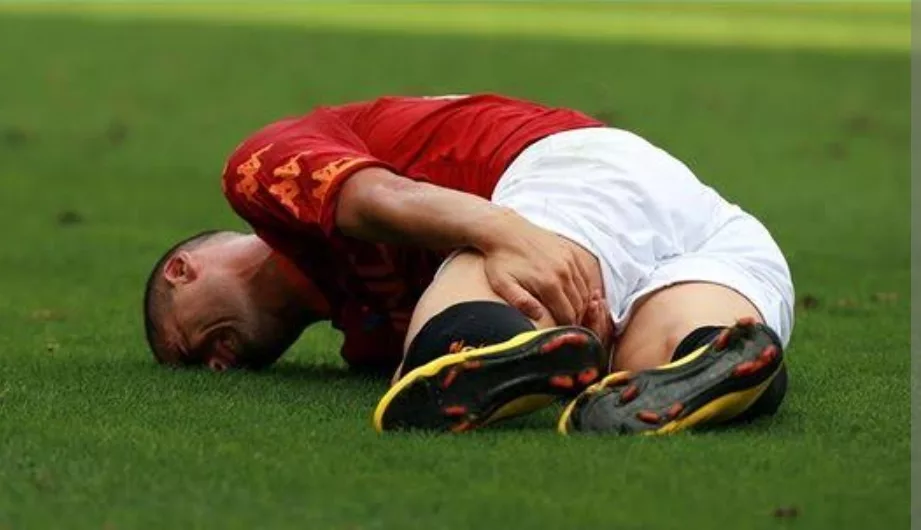A hamstring injury refers to damage or strain to the muscles or tendons located at the back of the thigh. The hamstrings are a group of three muscles that run along the back of the thigh, and injuries often occur during activities that involve sudden acceleration, deceleration, or overstretching of these muscles.
Symptoms of a hamstring injury may include pain, swelling, Tenderness, Loss of motion, Decreased length of the hamstrings and limited range of motion. Proper rest and rehabilitation are essential for recovery.
Also read: Booking : 5 Wonderful Things You Will Do To Earn Big Money From Online

Hamstring injury is caused by a rapid extensive contraction or a violent stretch of the hamstring muscle group which causes high mechanical stress. This results in varying degrees of rupture within the fibres of the musculotendinous unit. Hamstring strains are common in sports with a dynamic character like sprinting, jumping e.t.c.
These muscles play a crucial role in bending the knee and extending the hip. The primary muscles that make up the hamstring group are:
Biceps Femoris: This muscle has two heads (long head and short head) and is located on the outer side of the thigh.
Semimembranosus: Positioned on the inner side of the thigh, this muscle is one of the hamstring’s three components.
Semitendinosus: Also situated on the inner side of the thigh, this muscle is another component of the hamstring group.
The “Biceps Femoris” is on the outer side of the thigh.
The “Semimembranosus” and “Semitendinosus” are on the inner side of the thigh. These muscles work together to allow movements such as bending the knee and extending the hip, playing a crucial role in various physical activities.
Adverse Effects of hamstring injury
Also read: Sports Booking : How Best To Make Huge Profits From Online Booking
- Its can lead to older age
- Limited hamstring flexibility
- Increased fatigue
- Poor core stability
- Strength imbalance
What are the prevention measures of Hamstring Muscle Injury
Warm-Up: Perform thorough warm-up exercises before engaging in physical activities. This helps increase blood flow to the muscles and prepares them for more intense activity.
Stretching: Include regular hamstring stretching in your routine to improve flexibility and reduce the risk of strains. Dynamic stretches are particularly beneficial.
Strength Training: Strengthen the muscles around the hamstrings, especially the quadriceps and glutes, to provide better support and stability.
Proper Technique: Ensure proper technique and form during exercises and sports activities. Incorrect movements can increase the risk of injury.

Gradual Progression: Gradually increase the intensity and duration of your activities. Sudden, intense workouts can strain the muscles.
Rest and Recovery: Allow sufficient time for rest and recovery between intense workouts to prevent overuse and fatigue.
Hydration and Nutrition: Stay hydrated and maintain a balanced diet to support muscle health and overall fitness.
Appropriate Footwear: Wear appropriate footwear for specific activities to provide proper support and reduce the risk of injury.
Listen to Your Body: Pay attention to any warning signs, such as tightness or discomfort in the hamstrings. If you feel something is off, take a break and assess the situation.
Also read: Football Academy : 5 Top Academies You Can Join For Free In Nigeria
Consult a Professional: If you are unsure about your exercise routine or if you have a history of hamstring injuries, consider consulting with a fitness professional or physiotherapist for personalized guidance.
Remember, a combination of these preventive measures contributes to a comprehensive approach to minimize the risk of hamstring muscle injuries.
Treatment for hamstring injury typically involves a combination of rest, ice, compression, and elevation (RICE) in the initial stages. Here are some common methods:
Rest: Allow the hamstring muscle to heal by avoiding activities that strain or cause pain in the injured area.
Ice: Apply ice packs to the affected area for 15-20 minutes every 2-3 hours during the first 48 hours to reduce swelling and pain.
Compression: Use a compression bandage to help reduce swelling and provide support to the injured muscle.
Elevation: Elevate the leg when possible to minimize swelling.

Pain Medications: Over-the-counter pain relievers such as ibuprofen or acetaminophen can help manage pain and reduce inflammation around the hamstring injury area.
Physical Therapy: Once the acute phase has passed, a physical therapist can design a rehabilitation program to strengthen the hamstring and improve flexibility.
Stretching and Strengthening Exercises: Gradual introduction of specific exercises to stretch and strengthen the hamstring muscles can aid in recovery.
Ultrasound or Laser Therapy: Some healthcare professionals may use therapeutic ultrasound or laser therapy to promote healing and reduce inflammation.

Massage Therapy: Massage can help improve blood circulation, reduce muscle tension, and promote healing.
Also read: NFF Begins Contract Talk With Former Super Falcons Head Coach
It’s crucial to consult with a healthcare professional for an accurate diagnosis and personalized treatment plan tailored to the severity of the injury.
Severe cases of hamstring injury, it may require more advanced interventions, and surgery might be considered in extreme cases, although it’s relatively uncommon for hamstring injuries.
How can Hamstring injury affect your daily life
Pain and Discomfort: Hamstring injuries often cause pain, making it uncomfortable to perform everyday activities such as walking, standing, or sitting.
Mobility Issues: Severe injuries may lead to limited mobility, affecting your ability to move around easily. Climbing stairs or getting in and out of a chair may become challenging.
Impaired Performance in Physical Activities: Engaging in sports, exercise, or even routine physical activities may be compromised due to the injury, affecting your overall fitness and well-being.
Impact on Work: Jobs that involve physical labor or require prolonged periods of sitting may be challenging. Even office tasks can be affected if sitting causes discomfort, hence need the take hamstring injury serious and always be careful.
Sleep Disturbance: Finding a comfortable sleeping position can be difficult with a hamstring injury, potentially leading to disrupted sleep patterns.
Cruciate Ligament Injury! Athletes Nightmare, Meaning, Ways To Manage And Avoid It
Mood and Emotional Impact: Chronic pain and limitations in daily activities may contribute to feelings of frustration, stress, or even depression.
Dependency on Others: In severe cases, you may need assistance with daily tasks, leading to increased dependency on friends, family, or caregivers.

Extended Recovery Time: Hamstring injuries can have a prolonged recovery period, requiring patience and adjustments to your daily routine.
It’s essential to seek appropriate medical attention, follow recommended treatment plans, and gradually reintroduce activities as your hamstring injury heals to minimize the impact on your daily life.
Additionally, consulting with a healthcare professional or physical therapist can help tailor a rehabilitation plan to facilitate a smoother recovery process.
According to Mayo clinics, hamstring injury can mean pulling one of the hamstring muscles.





